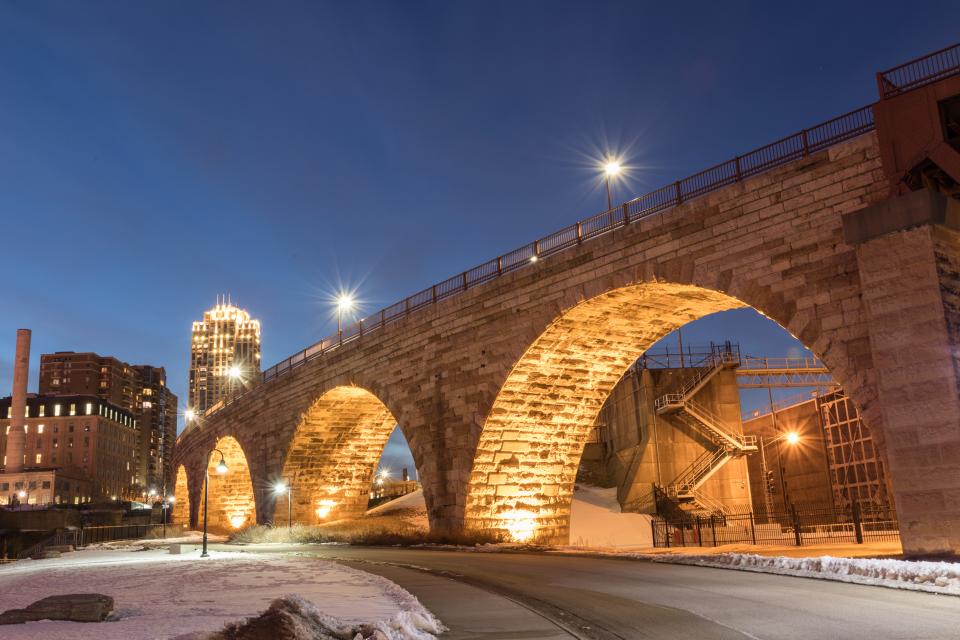
All of its stones were placed using ropes, pulleys, horses, and men. It was a masonry construction of stone from local sources, with granite from Sauk Rapids for the pilings, limestone from the riverbank for the fill, magnesium limestone from Mankato and Stone City, Iowa, for the facing, and marble from Bridgeport, Wisconsin, for the trim. No new technology was used to build the bridge, despite its innovative design. The bridge stretched 2,100 feet long and twenty-eight feet wide-enough width for two tracks to run side by side. Achieving the curve as designed required twenty-three arches varying in size from forty to 100 feet wide. Anthony Falls, and the fragile stone underlying the area. Smith designed the bridge with a curve due to the site's physical restrictions, which included pre-existing buildings, St. Hill commissioned the Stone Arch Bridge in 1881 to carry freight and passengers to and from Minneapolis on his St. (2008): Design of Arch Bridges.Built over the course of twenty-two months in 18, the Stone Arch Bridge across the Mississippi River in Minneapolis is a feat of engineering and a reminder of the importance of rail traffic in the late nineteenth century. You can send an e-mail to or a whatsapp message to +2347053638996. Remember to contact us for your structural designs, detailing, and project management and training. Thank you for visiting Structville today, and God bless you. Other actions on bridges should also be considered. For design purposes, the self weight and traffic actions can be combined using 1.35Gk + 1.5Qk. There are other forces such as torsion that should be checked in the analysis result. The variation of bending moment as wheel load travels through the bridge deck is shown below Variation of bending moment as wheel load travels through bridge deck Variation of bending moment as wheel load travels through bridge deck Variation of bending moment as wheel load travels through bridge deck Maximum axial force in column (spandrel) = 160 kN (1st column from the left) Maximum axial force in arch rib = 855 kN (compression) Maximum shear force in column (spandrel) = 28.8 kN (4th column from the left) Axial force diagram under UDL traffic action The structural form can be said to be a bit similar to that of Krka River Bridge in Croatia. The general structural form of the bridge is shown below. We are going to demonstrate this using a parabolic arch bridge.

#Stone arch bridge pro
It is possible to model and analyse arch bridges using Staad Pro software. whether or not a tie should be introduced, or the stiffness of the deck relative to the arch. The flatter the arch the greater the horizontal thrust and this may affect the structural form selected, i.e. According to, the ratio of span to rise should generally be in the range of 2:1 to 10:1. However, the parabolic arch is the most popular shape for arch bridges. In terms of shape, an arch bridge can be segmental (circular), parabolic, or elliptical. An example of a three-hinged arch bridge is the Rossgraben Bridge in Switzerland.
#Stone arch bridge free
Statically determinate arch structures are free from secondary stresses from indirect actions such as differential settlement and temperature difference. While the former is statically indeterminate, the later is statically determinate. A hinged arch can be two-hinged arch or three-hinged arch. However in terms of structural form, arches can be broadly classified as hinged or fixed. The structural scheme adopted in any arch bridge can be influenced by a lot of factors such as the type of deck, environmental conditions, cost, and feasibility.

The structural form consists of tied timber truss arches supporting the bridge deck with the use of suspension cables.
#Stone arch bridge full
The Tynset Bridge in Norway built in the year 2001 is considered the longest timber bridge in the world designed for full highway loading with a span of 70 m. Also, the Eagle River Timber Bridge in Michigan is another example of three-hinged arch timber bridge with a span of about 23-24 metres.

It is considered to be the largest cantilevered timber bridge in Europe.

An example of a timber arch bridge is the Mur River Bridge in Austria (also called the Holzeuropabrücke wood bridge) which is made of three-hinged parabolic timber. However, in recent times, timber bridges are usually restricted to small spans. Arch bridges can be classified according to the following Īs far as materials is concerned, arch bridges can be constructed from timber, stone masonry, bricks, concrete, or steel.


 0 kommentar(er)
0 kommentar(er)
